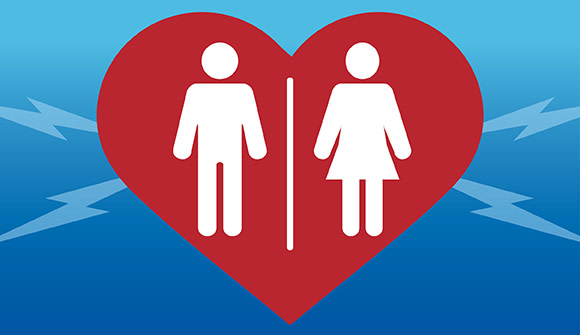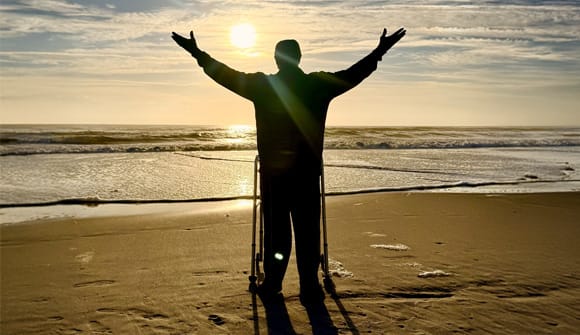Bad valve
If you need to know how well your heart is working, there’s a procedure for that.
Article Author: Johnny Woodhouse
Article Date:

Cardiac catheterization, a procedure to examine how well your heart is working, has been around for almost a century.
The first one was performed in 1929 by a German cardiologist who went on to win a Nobel Prize in medicine.
Today, more than 1 million cardiac or heart catheterizations are performed annually in the United States.
My cardiologist, Mona Shah, MD, of Baptist Heart Specialists, has been wanting to “cath me” for over a year, and for good reason.
I have what’s called aortic valve disease, a condition in which the valve between the main pumping chamber of the heart (left ventricle) and the main artery in the body (aorta) doesn’t work properly. I also have a heart murmur, an unusual sound heard between heartbeats.
Some heart murmurs aren’t life-threatening, but others, like the one I have, are a sign of an underlying problem. In my case, my aortic value has narrowed considerably over time, preventing the valve from opening fully, which reduces or blocks blood flow from my heart into the aorta and on to the rest of my body.
Without getting too technical, my aortic valve is shot and needs to be surgically removed and replaced with a new one. But before that happens, Dr. Shah scheduled me for a diagnostic heart catheterization procedure to see if any of my coronary arteries were blocked.
Catheter-based procedure
Over the past few years, I’ve had every heart test known to man, including a half a dozen echocardiograms (an ultrasound to evaluate heart structure) and a couple of treadmill stress tests to see how well my ticker handles physical activity. I even wore a heart monitor (Holter) for 24 hours to check for an irregular heart rhythm, a condition known as atrial fibrillation that can lead to heart failure, blood clots or stroke.
The physician who performed my heart catheterization was Salil Patel, MD, an interventional cardiologist with Baptist Heart Specialists. Dr. Patel specializes in treating cardiovascular disease and structural heart conditions through catheter-based procedures such as angioplasty and stenting.
In other words, he fixes heart conditions acquired through wear and tear, such as a leaky heart valve or a clogged artery.
While I was being prepped for the procedure at Baptist Heart Hospital, Dr. Patel met me in the pre-op room to explain the process and let me know what to expect to reduce any anxiety on my part (or my wife’s). He said the procedure would include moderate (conscious) sedation, a combination of medicines to help me relax and to block pain to the insertion site, either the groin or the wrist.
He inserted a long thin tube (catheter) through the radial artery in my right arm, threading it through the blood vessels all the way to my heart. Once there, he took the tip of the catheter into various parts of my heart to measure the pressures within my heart chambers and injected contrast dye to check blood flow through them.
During a heart catheterization, interventional cardiologists like Dr. Patel can perform a number of procedures, including:
- Angioplasty – inflating a tiny balloon at the tip of the catheter to press any plaque buildup against the artery wall and improve blood flow through the artery
- Stent placement – inserting a tiny metal mesh coil or tube at the end of the catheter inside an artery to keep it open
- Biopsy – Taking out a small tissue sample of the heart to examine for abnormalities
Clean and green
During the procedure, I was lying face-up on an operating table in the “cath lab.” Both my arms were strapped to my side, with my right wrist turned upward. The room was very chilly but a nurse made sure I had enough warm blankets to keep me comfortable.
As Dr. Patel navigated the catheter around my heart, I could watch the process on a large computer screen to my left. They don’t call it conscious sedation for nothing.
After about 30 minutes, I was wheeled out of the lab and back to a recovery room. The sedation wore off pretty fast and I was sitting up, eating and drinking in no time. Dr. Patel came in about an hour later to let me know all my coronary arteries were “clear.”
Because my heart catheterization turned out to be diagnostic in nature and not interventional, I won’t need traditional open-heart surgery to replace my failing aortic value, which is a huge relief!
I recently set a date for my minimally invasive aortic valve replacement (mini AVR), which will involve a catheter inserted through the groin and a minimal incision on the chest. The procedure takes a few hours and most patients are moving around and driving in under two weeks.
Scientists in Munich, Germany, have discovered that endurance and strength training following a heart valve replacement not only improves the patient’s physical fitness, but also their quality of life.
I enjoy working out a lot, including swimming in the ocean, so that’s music to my ears!
If you are experiencing chest pain or shortness of breath, call 911 or go to the Emergency Room immediately.
The Structural Heart Program at Baptist Heart Specialists is comprised of a collaborative team of interventional cardiologists and cardiothoracic surgeons specializing in the diagnosis and treatment of conditions affecting the valves and other vital structures of the heart. To make an appointment with a structural heart scheduler, call 904.202.9500.



